The Top 10 Loudest Animals on Earth (#1 is Amazing)
Key Points:
- The loudest animal on earth is the sperm whale, which can produce a clicking sound up to 233 decibels. Sperm whales are also the largest toothed whales on earth, and have larger brains than any other animal. Scientists believe that the sperm whale’s head acts as a giant telegraph machine.
- The greater bulldog bat has a screech is 100 times louder than a rock concert. The greater bulldog bat has the highest sound frequency of all bat species, but it does not carry as well through the air as those with lower frequency screeches.
- Male howler monkeys have a deafening scream of up to 140 decibels, used to attract females or compete with other males.
Stop and think of the loudest person that you know. They are not even close to the loudness of the noisiest animals on earth. While many animals count on being very quiet to surprise their prey, these animals use their loudness in extraordinary ways, such as finding another individual, defending territory, romancing a mate, or warning their companions of predators. The average human conversation is about 50 decibels, and the human eardrum will rupture at about 200 decibels. Yet, many of these animals approach that level regularly. This list of the loudest animals on earth has been compiled by the decibel levels they can produce.
#10. North American Bullfrog
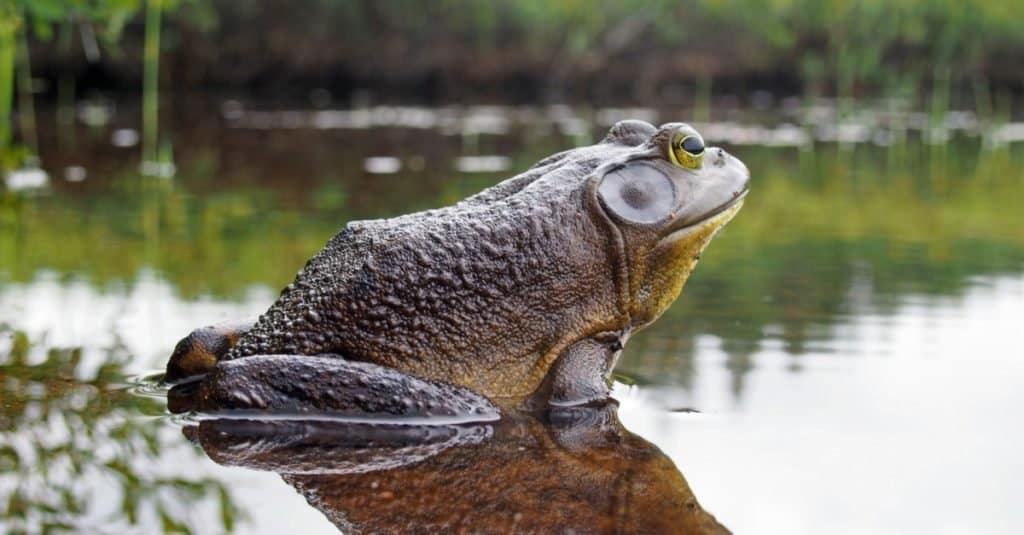
Christian Ouellet/Shutterstock.com
The North American bullfrog makes several different sounds to communicate. The loudest sound, which can be about 119 decibels, is made with an open mouth while the frogs make all others with a closed mouth. This loud sound is a distress scream. Bullfrogs will also emit low, growling sounds when caught, and they are struggling to escape. They make a grinding sound when they are talking to each other. Male bullfrogs will make a short, sharp call when another male tries to enter its territory. The most common call from a bullfrog is the advertisement calls that males make near breeding areas. In some cases, older females may also make advertisement calls.
#9. African Cicadas

suradech123yim/Shutterstock.com
There are more than 3,600 species of African cicadas, with more being discovered regularly. While they are all loud, the loudest may be the Green Grocer and the Yellow Monday. These insects produce sounds up to 120 decibels that carry up to 1.5 miles away. Only male cicadas make any sound, and they do it to attract females. They are unique in the insect world because they have special parts in their abdomens, called tymbels. Cicadas use muscles throughout their bodies to contract their abdomen to produce the sound.
#8. Northern Elephant Seal

FiledIMAGE/Shutterstock.com
Female Northern elephant seals make sounds to communicate with their pups. Young pups can be noisy when mom is not close by, and they sense danger. The male Northern elephant seal makes the loudest sound, which can be up to 126 decibels. Researchers believe that each Northern elephant seal has its unique voice.
Furthermore, researchers believe that this is the only animal outside of humans that makes decisions based on an individual’s vocalizations. If a Northern elephant seal moves to a new rookery, they learn a whole new language as each rookery has its dialect. While Northern elephant seals can make sounds on land and water, they are usually only real noisy while on land or nearby.
Males make the loudest sounds to warn other males that this is their territory. Then, the other male decides to challenge that male or move on to a different area depending on the sound. This is the only animal that researchers know of that can make decisions based on the sound of each individual voice, except for humans.
#7. Moluccan Cockatoo
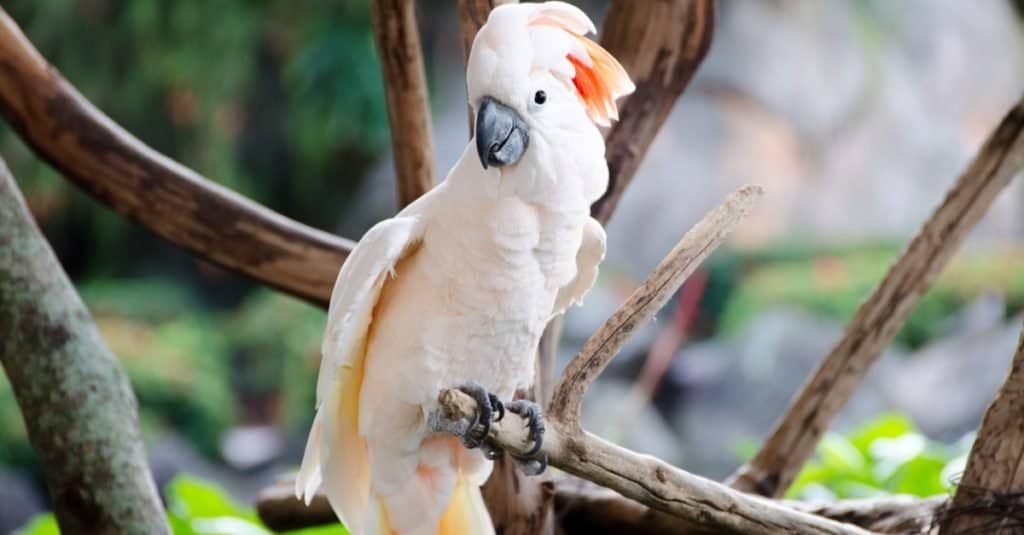
CG3/Shutterstock.com
Moluccan cockatoo can scream up to 129 decibels about the same level as a 747 jet. Like dogs, if you own a Moluccan cockatoo, they will scream to alert you that they sense trouble nearby. Their scream is used to alert their flock of possible danger. They also make a ritual of calling in the morning and at night for 20-25 minutes at a time.
If you have more than one as a pet, they will often scream simultaneously, and it is usually right before bedtime. And be careful, as their screech is powerful enough to damage human hearing if you happen to be too close!
#6. Kakapos
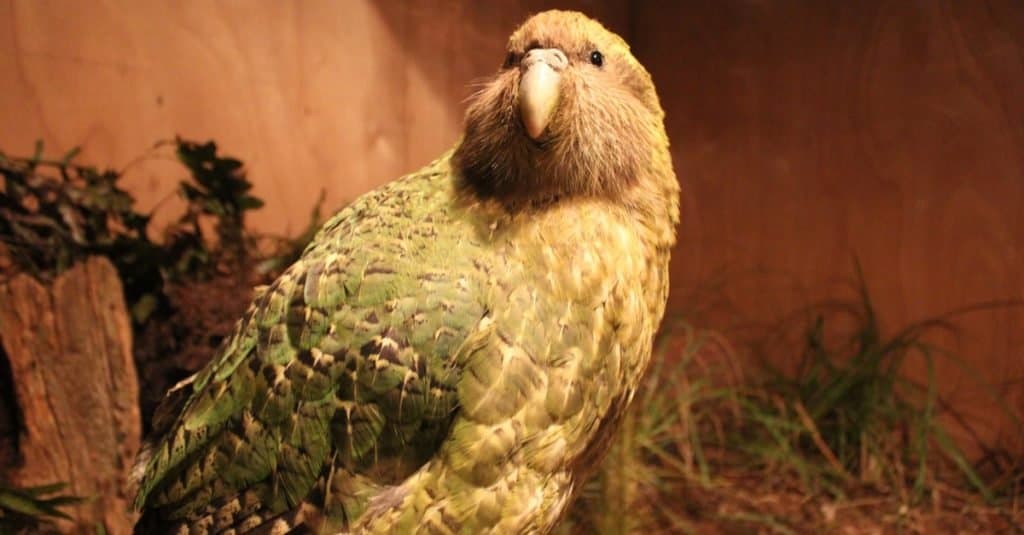
Imogen Warren/Shutterstock.com
The kakapo is the world’s largest parrot and one of its rarest. If it was not for the work of Don Merton and others with the Kakapo Recovery Programme in New Zealand, this flightless bird might have become extinct. When researchers first discovered this bird was still alive, they found only males. Then, they found four females. With less than 84 known birds in 2000, the researchers felt that they had to act quickly.
To save the bird, they air-flighted the bird that was a favorite of weasels and ferrets to a remote island where the coast was so rugged that a boat could not dock. They chose the remote CodfishIsland, off New Zealand’s southern coast, because there were no predators on the island. As of 2020, the number of kakapos had rebounded to 211 adult birds. Saving this bird has not been an easy task as they typically only breed every 4-to-5 years and do not start until they are at least 4 years old.
Male kakapos often make calls up to 132 decibels to attract females. Once they have mated, however, they leave the female kakapos to lay one to four eggs and feed the young on their own. The flightless kakapos must secure up to 16 rimu nuts per minute to feed each nestling all night long. During this process, which can last up to 6 months, the female often loses half of her body weight.
During the breeding season, males gather on rocks to make their loud calls, consisting of 20-to-30 sonic-like booms followed by a metallic-sounding ching. This loud pattern can continue for up to 8 hours nightly.
#5. Howler Monkey

Anton_Ivanov/Shutterstock.com
Male howler monkey screams can reach up to 140 decibels. The loudness of the monkey’s vocalizations depends on at least four different factors. The scream will appear louder in environments where the sound echoes well. Secondly, if a female is attracted to the sound, then the male will get even louder in an attempt to get her excited.
Third, if the howler monkey is competing with other males, they will try to scream as loud as they can howl. Finally, the subspecies that howl the loudest usually uses very few other ways to attract females while those who do not scream as loud use other methods.
#4. Greater Bulldog Bat
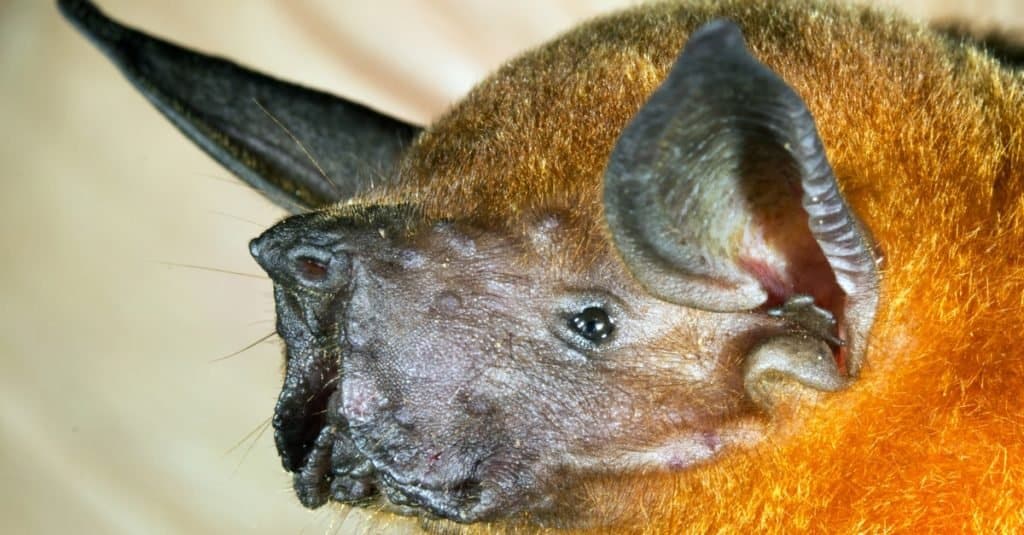
If you think of bats as quiet animals, you would be wrong in the case of the greater bulldog bat who lives in Mexico, Argentina, and some Caribbean islands. Their screech is 100 times louder than a rock concert. Different bat species screech at unique frequencies, which may help other bats tell species apart at a distance. The greater bulldog bat has the highest sound frequency, but it does not carry as well through the air as those with lower frequency screeches.
Now, scientists are applying the knowledge they have gained from bats to make robots perform better, especially in the dark. Scientists also believe that they have mismeasured the decibel level of bats in the past and that small bats like the greater bulldog bat, which weighs about 1.7 ounces or about the same as 10 U.S. nickels, may be much louder than previously thought.
#3. Blue Whales

Wild_and_free_naturephoto/Shutterstock.com
The blue whale is one of the biggest animals alive, so it may not come as any surprise that it also has one of the loudest sounds. The blue whale sounds, however, are the same frequency as many other sounds found in the oceans where it lives, including ship engines, low-frequency active sonar, and seismic air gun array explorations. While blue whales often travel thousands of miles alone, this ocean noise pollution can cause severe problems in feeding, breeding, navigation, and communication.
#2. Mantis Shrimp
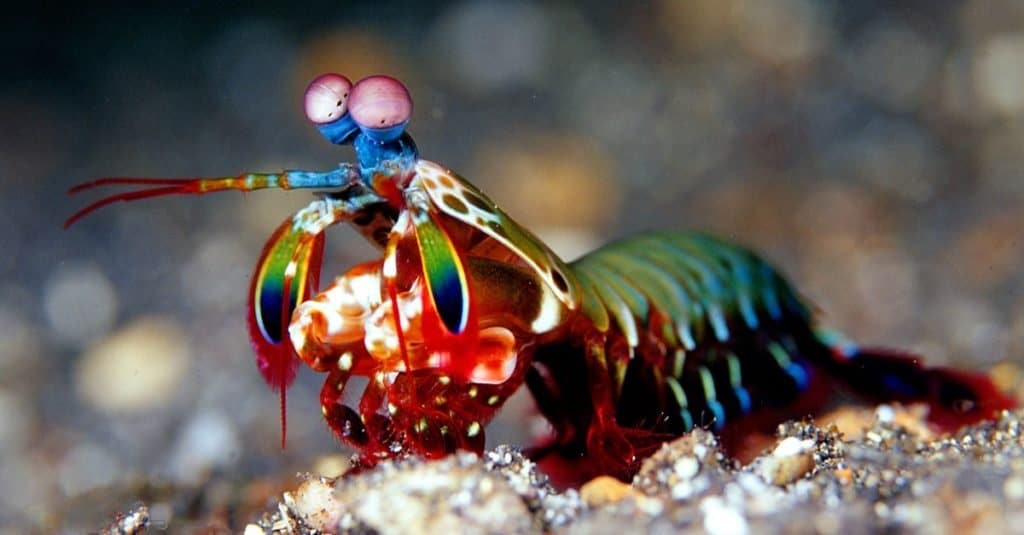
Mantis shrimp living in tropical and temperate seas have a unique claw that they can close very rapidly to catch prey. When they close the claw, it produces a loud popping sound from the formed water bubble. This sound can be up to 200 decibels. The sound scares the prey, giving them time to catch and dismantle it for their meal. When the water bubble breaks, it also causes a natural light to shine, further distracting their prey. This is the only animal in the world that produces sound during the cavitation process. The process may also release heat that is hotter than the sun’s surface.
#1. Sperm Whale

wildestanimal/Shutterstock.com
The sperm whale, capable of producing clicking sounds up to 233 decibels, is the loudest animal on earth. That’s not the only category it leads. The sperm whale is also the largest toothed whale on earth, and has a larger brain than any other animal. Early whalers reported hearing sounds, like a hammer, whenever they had caught a sperm whale. Scientists now know that these reports are accurate, and they believe that the sperm whale’s head acts as a giant telegraph machine.
It makes these sounds by forcing air into its right nostril. The nostril runs by a series of air-filled sacs. A unique part of the whale’s body, called monkey lips, clamps shut, and the air continues to bounce off the sacs making the unique clicking sound. Then, the sound travels through the animal’s brain, where it amplifies even louder before the sound finally leaves the whale’s body.
Sperm whales can emit at least three different types of clicks. One it uses as a long-range type of sonar. The most common click is a click that sounds similar to a squeaky door and means that prey capture is imminent. The whale also has a unique cooing click that it uses when socializing with other animals.
Summary of the Top 10 Loudest Animals on Earth
Let’s review the animals that exhibit the most volume in the world:
| Rank | Animal |
|---|---|
| 1 | Sperm Whale |
| 2 | Mantis Shrimp |
| 3 | Blue Whale |
| 4 | Greater Bulldog Bat |
| 5 | Howler Monkey |
| 6 | Kakapo |
| 7 | Moluccan Cockatoo |
| 8 | Northern Elephant Seal |
| 9 | African Cicada |
| 10 | North American Bullfrog |
Up Next…
- 9 Smallest Reptiles in the World Meet the smallest reptiles in on Earth in this interesting article.
- Meet the Biggest Horses in the World From Clydesdales to Shires, here’s a look at the horses that tip the scale as the biggest.
- Amazing! 12 Types of Hybrid Animals That Actually Exist Did you know that there are a variety of fascinating hybrid animals that will make your jaw drop? Read on to discover them.
More from A-Z Animals
Key Points:
- The loudest animal on earth is the sperm whale, which can produce a clicking sound up to 233 decibels. Sperm whales are also the largest toothed whales on earth, and have larger brains than any other animal. Scientists believe that the sperm whale’s head acts as a giant telegraph machine.
- The greater bulldog bat has a screech is 100 times louder than a rock concert. The greater bulldog bat has the highest sound frequency of all bat species, but it does not carry as well through the air as those with lower frequency screeches.
- Male howler monkeys have a deafening scream of up to 140 decibels, used to attract females or compete with other males.
Stop and think of the loudest person that you know. They are not even close to the loudness of the noisiest animals on earth. While many animals count on being very quiet to surprise their prey, these animals use their loudness in extraordinary ways, such as finding another individual, defending territory, romancing a mate, or warning their companions of predators. The average human conversation is about 50 decibels, and the human eardrum will rupture at about 200 decibels. Yet, many of these animals approach that level regularly. This list of the loudest animals on earth has been compiled by the decibel levels they can produce.
#10. North American Bullfrog

Christian Ouellet/Shutterstock.com
The North American bullfrog makes several different sounds to communicate. The loudest sound, which can be about 119 decibels, is made with an open mouth while the frogs make all others with a closed mouth. This loud sound is a distress scream. Bullfrogs will also emit low, growling sounds when caught, and they are struggling to escape. They make a grinding sound when they are talking to each other. Male bullfrogs will make a short, sharp call when another male tries to enter its territory. The most common call from a bullfrog is the advertisement calls that males make near breeding areas. In some cases, older females may also make advertisement calls.
#9. African Cicadas

suradech123yim/Shutterstock.com
There are more than 3,600 species of African cicadas, with more being discovered regularly. While they are all loud, the loudest may be the Green Grocer and the Yellow Monday. These insects produce sounds up to 120 decibels that carry up to 1.5 miles away. Only male cicadas make any sound, and they do it to attract females. They are unique in the insect world because they have special parts in their abdomens, called tymbels. Cicadas use muscles throughout their bodies to contract their abdomen to produce the sound.
#8. Northern Elephant Seal

FiledIMAGE/Shutterstock.com
Female Northern elephant seals make sounds to communicate with their pups. Young pups can be noisy when mom is not close by, and they sense danger. The male Northern elephant seal makes the loudest sound, which can be up to 126 decibels. Researchers believe that each Northern elephant seal has its unique voice.
Furthermore, researchers believe that this is the only animal outside of humans that makes decisions based on an individual’s vocalizations. If a Northern elephant seal moves to a new rookery, they learn a whole new language as each rookery has its dialect. While Northern elephant seals can make sounds on land and water, they are usually only real noisy while on land or nearby.
Males make the loudest sounds to warn other males that this is their territory. Then, the other male decides to challenge that male or move on to a different area depending on the sound. This is the only animal that researchers know of that can make decisions based on the sound of each individual voice, except for humans.
#7. Moluccan Cockatoo

CG3/Shutterstock.com
Moluccan cockatoo can scream up to 129 decibels about the same level as a 747 jet. Like dogs, if you own a Moluccan cockatoo, they will scream to alert you that they sense trouble nearby. Their scream is used to alert their flock of possible danger. They also make a ritual of calling in the morning and at night for 20-25 minutes at a time.
If you have more than one as a pet, they will often scream simultaneously, and it is usually right before bedtime. And be careful, as their screech is powerful enough to damage human hearing if you happen to be too close!
#6. Kakapos

Imogen Warren/Shutterstock.com
The kakapo is the world’s largest parrot and one of its rarest. If it was not for the work of Don Merton and others with the Kakapo Recovery Programme in New Zealand, this flightless bird might have become extinct. When researchers first discovered this bird was still alive, they found only males. Then, they found four females. With less than 84 known birds in 2000, the researchers felt that they had to act quickly.
To save the bird, they air-flighted the bird that was a favorite of weasels and ferrets to a remote island where the coast was so rugged that a boat could not dock. They chose the remote CodfishIsland, off New Zealand’s southern coast, because there were no predators on the island. As of 2020, the number of kakapos had rebounded to 211 adult birds. Saving this bird has not been an easy task as they typically only breed every 4-to-5 years and do not start until they are at least 4 years old.
Male kakapos often make calls up to 132 decibels to attract females. Once they have mated, however, they leave the female kakapos to lay one to four eggs and feed the young on their own. The flightless kakapos must secure up to 16 rimu nuts per minute to feed each nestling all night long. During this process, which can last up to 6 months, the female often loses half of her body weight.
During the breeding season, males gather on rocks to make their loud calls, consisting of 20-to-30 sonic-like booms followed by a metallic-sounding ching. This loud pattern can continue for up to 8 hours nightly.
#5. Howler Monkey

Anton_Ivanov/Shutterstock.com
Male howler monkey screams can reach up to 140 decibels. The loudness of the monkey’s vocalizations depends on at least four different factors. The scream will appear louder in environments where the sound echoes well. Secondly, if a female is attracted to the sound, then the male will get even louder in an attempt to get her excited.
Third, if the howler monkey is competing with other males, they will try to scream as loud as they can howl. Finally, the subspecies that howl the loudest usually uses very few other ways to attract females while those who do not scream as loud use other methods.
#4. Greater Bulldog Bat

If you think of bats as quiet animals, you would be wrong in the case of the greater bulldog bat who lives in Mexico, Argentina, and some Caribbean islands. Their screech is 100 times louder than a rock concert. Different bat species screech at unique frequencies, which may help other bats tell species apart at a distance. The greater bulldog bat has the highest sound frequency, but it does not carry as well through the air as those with lower frequency screeches.
Now, scientists are applying the knowledge they have gained from bats to make robots perform better, especially in the dark. Scientists also believe that they have mismeasured the decibel level of bats in the past and that small bats like the greater bulldog bat, which weighs about 1.7 ounces or about the same as 10 U.S. nickels, may be much louder than previously thought.
#3. Blue Whales

Wild_and_free_naturephoto/Shutterstock.com
The blue whale is one of the biggest animals alive, so it may not come as any surprise that it also has one of the loudest sounds. The blue whale sounds, however, are the same frequency as many other sounds found in the oceans where it lives, including ship engines, low-frequency active sonar, and seismic air gun array explorations. While blue whales often travel thousands of miles alone, this ocean noise pollution can cause severe problems in feeding, breeding, navigation, and communication.
#2. Mantis Shrimp

Mantis shrimp living in tropical and temperate seas have a unique claw that they can close very rapidly to catch prey. When they close the claw, it produces a loud popping sound from the formed water bubble. This sound can be up to 200 decibels. The sound scares the prey, giving them time to catch and dismantle it for their meal. When the water bubble breaks, it also causes a natural light to shine, further distracting their prey. This is the only animal in the world that produces sound during the cavitation process. The process may also release heat that is hotter than the sun’s surface.
#1. Sperm Whale

wildestanimal/Shutterstock.com
The sperm whale, capable of producing clicking sounds up to 233 decibels, is the loudest animal on earth. That’s not the only category it leads. The sperm whale is also the largest toothed whale on earth, and has a larger brain than any other animal. Early whalers reported hearing sounds, like a hammer, whenever they had caught a sperm whale. Scientists now know that these reports are accurate, and they believe that the sperm whale’s head acts as a giant telegraph machine.
It makes these sounds by forcing air into its right nostril. The nostril runs by a series of air-filled sacs. A unique part of the whale’s body, called monkey lips, clamps shut, and the air continues to bounce off the sacs making the unique clicking sound. Then, the sound travels through the animal’s brain, where it amplifies even louder before the sound finally leaves the whale’s body.
Sperm whales can emit at least three different types of clicks. One it uses as a long-range type of sonar. The most common click is a click that sounds similar to a squeaky door and means that prey capture is imminent. The whale also has a unique cooing click that it uses when socializing with other animals.
Summary of the Top 10 Loudest Animals on Earth
Let’s review the animals that exhibit the most volume in the world:
| Rank | Animal |
|---|---|
| 1 | Sperm Whale |
| 2 | Mantis Shrimp |
| 3 | Blue Whale |
| 4 | Greater Bulldog Bat |
| 5 | Howler Monkey |
| 6 | Kakapo |
| 7 | Moluccan Cockatoo |
| 8 | Northern Elephant Seal |
| 9 | African Cicada |
| 10 | North American Bullfrog |
Up Next…
- 9 Smallest Reptiles in the World Meet the smallest reptiles in on Earth in this interesting article.
- Meet the Biggest Horses in the World From Clydesdales to Shires, here’s a look at the horses that tip the scale as the biggest.
- Amazing! 12 Types of Hybrid Animals That Actually Exist Did you know that there are a variety of fascinating hybrid animals that will make your jaw drop? Read on to discover them.






